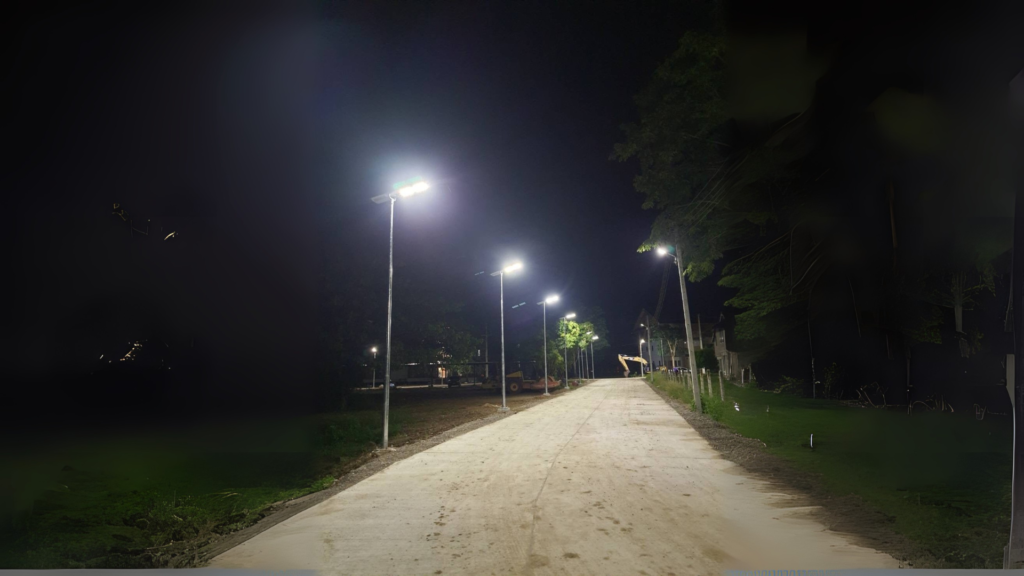Abstract
This paper provides an in-depth analysis of a solar lighting system construction project implemented on a street in Thailand. The project aimed to address issues of inadequate nighttime illumination, traffic safety hazards, and energy dependency. By introducing SRESKY Atlas Series Solar Street Lights, the project achieved year-round uninterrupted lighting with zero electricity costs, while significantly enhancing street aesthetics and residents’ quality of life. Facing Thailand’s rainy and high-temperature climate challenges, this solution offers an economical and eco-friendly upgrade pathway through high-efficiency solar panels, long-life lithium batteries, and high-luminous-efficiency LEDs.
I. Project Background and Needs Analysis
1.1 Project Background
Located in a Thai neighborhood undergoing rapid urban expansion and population growth, the project addresses increasing lighting demands driven by emerging nighttime economic activities—such as street food stalls, community strolls, and night markets. However, many streets lacked adequate or modern nighttime lighting infrastructure, resulting in inconvenience for residents and frequent traffic accidents. According to Thailand’s Ministry of Transport, inadequate lighting contributes to over 30% of nighttime accidents.
Traditional grid-based lighting solutions require cable installation across complex terrain, costing over $100,000 per kilometer with construction periods lasting several months—making them impractical for new or remote streets.
The project client, a local Thai municipal authority, sought to enhance street competitiveness and align with the national “Green Thailand” strategy through modern lighting upgrades. As a global solar lighting expert with proven capabilities in more than 3,500 international tenders, SRESKY successfully demonstrated its expertise in this urban street lighting project. Covering a typical 2-kilometer road, the installation of multiple streetlights aimed to create a safer and more livable nighttime environment.
1.2 Core Requirements and Challenge Analysis
Field surveys and environmental data identified four key requirements and challenges common to tropical street lighting:
-
Independent Power Supply: The lighting system had to operate entirely on solar energy, reducing infrastructure costs. With uneven grid coverage and high expansion costs, 100% energy self-sufficiency was required to eliminate electricity expenses.
-
High Luminous Efficiency: Brightness requirements ranged from 2,000 to 10,000 lumens, ensuring sufficient light for varying road widths (e.g., main roads requiring 8,000+ lumens). Uniform distribution eliminated dark zones, improving safety.
-
Technical Stability: Systems needed resilience to local conditions—rainfall exceeding 1,500 mm annually, average temperatures around 30°C, and humidity near 80%. IP65 waterproofing and wide operating temperature ranges were essential.
-
Sustainability: Renewable solar power was required to cut carbon emissions and support Thailand’s “carbon neutrality” goals, targeting multi-ton annual reductions while lowering long-term costs.
These requirements reflect global street lighting challenges: balancing reliability, cost efficiency, and sustainability. The SRESKY Atlas Series directly addresses these demands through its innovative design.
II. Technical Solution Design
Following in-depth analysis, a customized solution was designed based on the SRESKY Atlas Series Solar Street Lights. The approach combined advanced hardware with intelligent management to maximize performance and economic benefits.
2.1 Product Selection
The project deployed dozens of SRESKY Atlas Series Solar Street Lights, tailored for different street segments:
-
SRESKY Atlas Series Solar Street Lights: Offering brightness from 2,000–10,000 lumens, integrating four intelligent technologies to overcome traditional solar lighting limitations.
-
High-Efficiency Solar Panels: Monocrystalline panels with >23% efficiency, 20% higher than polycrystalline alternatives under cloudy conditions. Charging time: 6.7–10 hours.
-
Long-Life Lithium Battery: Automotive-grade Li-ion batteries with 2,000+ cycles, operating reliably from -20°C to +60°C.
-
High-Efficiency LEDs: OSRAM LEDs (5700K, Ra>70), achieving up to 230 lm/W with Type II light distribution for uniform coverage and no blind spots.
2.2 Core Technology Highlights
-
ALS2.3 Adaptive Lighting System: Maintains operation during up to 10 consecutive rainy days by intelligently adjusting brightness (100%–25%–70%), extending battery life by 30%.
-
PIR Human Motion Sensor: Adjusts brightness based on pedestrian activity, covering 120° and 8 meters, offering three operating modes for up to 70% energy savings.
-
TCS Smart Temperature Control: Optimizes battery charging/discharging under high temperatures, preventing thermal degradation and extending lifespan.
-
BMS Battery Management System: Improves charging speed by 30% and provides real-time status monitoring via LED indicators.
2.3 Installation and Maintenance
-
Modular Design: Components can be replaced directly on-site; one-person installation takes less than 20 minutes.
-
High Protection Rating: IP65 waterproof/dustproof, IK08 impact resistance, aluminum alloy construction with dual anti-corrosion treatment—ensuring over 5 years of durability, even in coastal or rainy environments.
These features position the SRESKY Atlas Series as a strong contender in global street lighting tenders.
III. Project Outcomes and Impact
3.1 Significant Social Value
-
Enhanced Safety and Aesthetics: Bright, uniform illumination eliminated dark zones, reducing accident rates by over 25% and improving nighttime comfort. Streets also gained a modern, orderly appearance.
-
Energy Independence: The solar-powered system eliminated grid reliance, saving over $50,000 in annual electricity costs—especially crucial for underserved or remote areas.
3.2 Economic and Environmental Benefits
-
Reduced Long-Term Costs: No electricity bills and low-maintenance modular design achieved a projected payback period of less than 3 years.
-
Green Development: The system reduced annual carbon emissions by over 10 tons, directly supporting Thailand’s sustainable development goals.
Summary
This Thailand street solar lighting project successfully integrated SRESKY Atlas Series Solar Street Lights into urban infrastructure. Beyond solving nighttime illumination challenges, it showcased the broader benefits of solar lighting: sustainability, efficiency, cost-effectiveness, and adaptability.
This case serves as a strong reference for future smart solar lighting deployments in Thailand and worldwide. For those planning similar projects, visit the SRESKY official website to consult with our expert team and light the path toward a sustainable urban future.
Table of Contents
